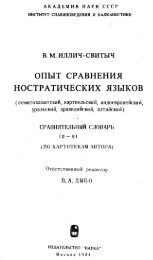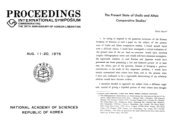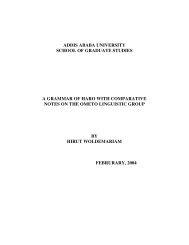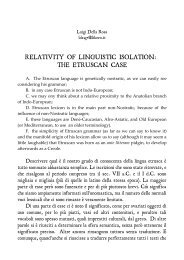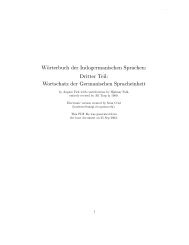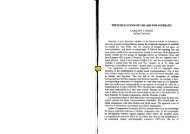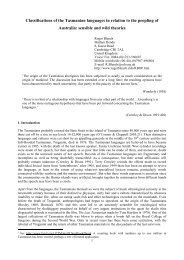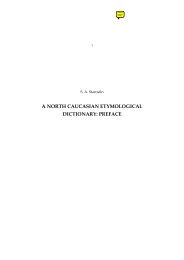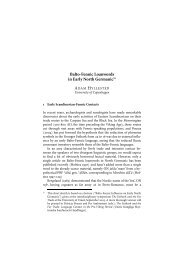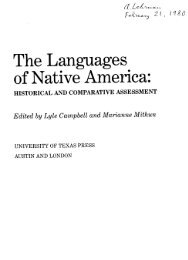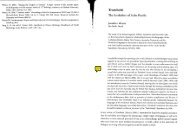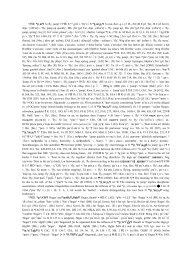The Indo-European Elements in Hurrian
The Indo-European Elements in Hurrian
The Indo-European Elements in Hurrian
You also want an ePaper? Increase the reach of your titles
YUMPU automatically turns print PDFs into web optimized ePapers that Google loves.
58 5. Pronouns, Numerals, Adpositions, Conjunctions, Adverbs<br />
<strong>Hurrian</strong> Numerals<br />
Wilhelm (2004a:115) lists the follow<strong>in</strong>g numerals one through ten <strong>in</strong> <strong>Hurrian</strong> (see also<br />
Friedrich 1969a:16; Bush 1964:108):<br />
Card<strong>in</strong>al Ord<strong>in</strong>al<br />
1. šukki, šuga (?) (?)<br />
2. š<strong>in</strong>(a) š<strong>in</strong>zi<br />
3. kig(a) kiški (< *kik=ši)<br />
4. tumni tumušše, tumunzi<br />
5. nariy(a) narišše<br />
6. šeže (?)<br />
7. š<strong>in</strong>di šendešši<br />
8. kira/i (?)<br />
9. tamri/a (?)<br />
10. eman emanzi, emašši (?)<br />
<strong>The</strong>re is noth<strong>in</strong>g comparable <strong>in</strong> <strong>Indo</strong>-<strong>European</strong> other than a superficial resemblance of the<br />
numeral šeže ‘six’ and Proto-<strong>Indo</strong>-<strong>European</strong> *s(w)e$s ‘six’. When the follow<strong>in</strong>g Semitic forms<br />
are considered, however, it is clear that the <strong>Hurrian</strong> numeral ‘six’ is a borrow<strong>in</strong>g from Semitic<br />
and, consequently, not related to the Proto-<strong>Indo</strong>-<strong>European</strong> numeral: Old Babylonian (m.) šiššet,<br />
(f.) šiš(š); Akkadian (m.) šeššet, šiššet, (f.) šiššu; Hebrew (m.) šiššāh, (f.) šēš; Aramaic (f.) šîθ;<br />
Arabic (m.) sittat, (f.) sitt.<br />
Wilhelm (2004a:115) notes the follow<strong>in</strong>g fractions: *ša/e¯t- ‘one-half’ and tumanzalli<br />
‘one quarter of a shekel’. <strong>Hurrian</strong> *ša/e¯t- ‘one-half’ may be compared with the Proto-<strong>Indo</strong>-<br />
<strong>European</strong> root *siHø- (> *sē-) found <strong>in</strong>: (1) *sē- ‘separately, apart’ (cf. Lat<strong>in</strong> sēd, sē ‘without;<br />
apart’); (2) *sē-t- ‘division, section’ (cf. Avestan hāiti- ‘division, section’; Latvian sę ta ‘hedge,<br />
section, division, staff’; (3) *sē-mi- ‘half’ (cf. Sanskrit [<strong>in</strong>decl<strong>in</strong>able] sāmi ‘half, <strong>in</strong>completely,<br />
imperfectly, partially’; Greek [prefix] ½μι- ‘half’; Lat<strong>in</strong> [prefix] sēmi- ‘half’).<br />
Another number is nubi ‘ten thousand’, and the suffix -gar- seems to be “dual”.<br />
<strong>Hurrian</strong> Adpositions, Conjunctions, Adverbs<br />
<strong>The</strong> follow<strong>in</strong>g <strong>Hurrian</strong> adpositions, conjunctions, and adverbs are attested (this material<br />
is cited <strong>in</strong> the form given <strong>in</strong> Laroche’s Glossaire):<br />
1. abi-n ‘before’ [+Dative] (from abi ‘the front part’)<br />
2. abi-da ‘toward’ [+Directive] (from abi ‘the front part’)<br />
3. adi ‘thus, so’<br />
4. ai ‘when, if’ [followed by a syntagm]<br />
5. anam(mi) ‘thus, therefore’ [used <strong>in</strong> correlation with <strong>in</strong>u(me)]



